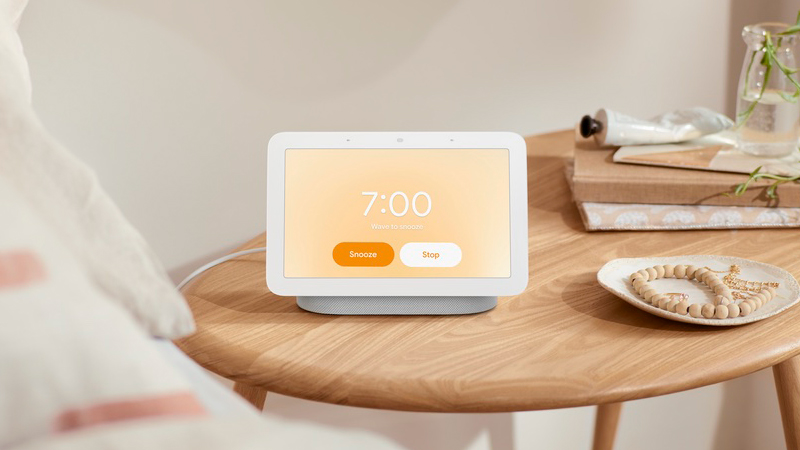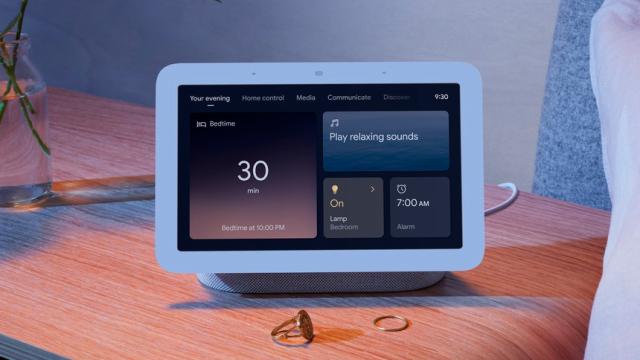Google hasn’t updated its smart display, the Google Home Hub, in more than two years, but today the company announced a brand new Nest Hub. While the updated version may look identical to its predecessor, Google makes up for it a fresh feature: the ability to track your sleep without requiring you to strap a band to your wrist.
Meet the new Google Nest Hub
The new Nest Hub resembles the old Google Home Hub, but with some new muted colour options for the fabric that cover’s the device’s speaker. Now you can choose from chalk, charcoal, sand, and mist (see below for the, uh, not so dazzling shades). Many had assumed that the Google Home Hub’s replacement would gain the camera introduced with the Nest Hub Max in early 2019, especially now that so many of our hours are spent video-chatting with friends, family, and co-workers. The new Nest Hub remains camera-less, that doesn’t mean it can’t still see its users.

Back in 2015, Google revealed an intriguing new technology it had helped develop called Project Soli. At its core was a small chip that used radar-based sensors to detect fine hand movements, allowing a device to be controlled at a distance using gestures instead of having to physically push a button or tap a screen. Project Soli eventually ended up in the Google Pixel 4 and 4 XL smartphones, and while Google left it out of the Pixel 5, the company said it would return in future products. Rumours swirled that Soli would be added to the next version of the Nest Thermostat, but those rumours turned out to be false when instead a more affordable version of the Nest Thermostat was revealed last October.
[referenced id=”879133″ url=”https://gizmodo.com.au/2015/05/the-new-moonshots-these-are-the-most-futuristic-ideas-from-google-io/” thumb=”https://gizmodo.com.au/wp-content/uploads/2015/05/30/1279453508154902417-300×149.png” title=”The New Moonshots: These Are The Most Futuristic Ideas From Google I/O” excerpt=”The most futuristic projects at Google come out of their advanced technologies and projects group, or ATAP. And today at Google I/O, the ATAP team unveiled their vision of tomorrow, where your body, behaviour and clothing will be the new interfaces that control your gadgets — and keep them secure,…”]
The Soli technology is finally available to consumers once again in the new Nest Hub, with two distinct uses. The first takes advantage of how Google has been hyping Soli all these years, allowing Nest Hub users to control various functions of its interface at a distance by making specific motions and gestures with their hands. That includes tapping in the middle of the air to pause or start playback, or snoozing an unwelcome morning alarm by simply waving a hand at the smart display — a gesture most of us can successfully perform even when barely awake.
The second use changes where users might want to install the Nest Hub. The original Google Home Hub was a device designed for use in either the bedroom as a private assistant, or a living room where the entire family could access it. With the addition of a camera (and the privacy concerns that came with it) the larger Nest Hub Max was a smart display that felt more at home in a room like a kitchen, but the new Nest Hub seems like it’s going to be most useful in the bedroom given what Soli can do now.

The biggest change is Sleep Sensing
Besides being the ultimate alarm clock with new features like a “Your evening” page that provides quick access to common bedtime routine functions like setting an alarm, turning off smart lights, and playing calming sounds to help you drift off, the new Nest Hub is introducing a brand new smart display feature called Sleep Sensing. Instead of detecting hand and finger gestures, at night the Soli technology on the Nest Hub measures the movements and breathing patterns of a person sleeping nearby (it works best when perched on a nightstand next to a bed) while other sensors like the microphone (listening for coughing and snoring), ambient light sensor, and digital thermometer keep track of other stimuli that could affect the quality of a user’s sleep. The user doesn’t need to wear anything, nor does their bed need to be upgraded with additional sensors.

In the morning, the Nest Hub’s Sleep Sensing provides a report of not only how a user slept, showing the times they tossed and turned or got out of bed, it also correlates those occurrences with other events like the temperature in the room increasing, or a light coming on, to help users pinpoint what might be causing their restless slumber. Over time the Sleep Sensing feature will also learn a user’s sleep patterns and make specific recommendations on how they could improve their sleep, including changing bed times, or reprogramming a smart thermostat’s behaviour throughout the night.

The sleep data can also be synced with Google Fit, which would provide other devices access to it, but Google promises that otherwise the data collected by Soli is completely anonymous and private, and that the sensors aren’t able to discern one person from another. (If both people sharing a bed want to use the sleep-tracking feature, a Nest Hub on either side of the bed is required.) Audio recordings of snoring, coughing, or talking in your sleep are stored and processed on the device itself, never sent to the cloud, and the Sleep Sensing feature is completely optional, requiring a user to first opt in before it’s activated.
Other new Nest Hub features include a speaker that pumps out 50% more bass than the original (just don’t expect the same audio performance as the Google Nest Audio), a third mic to help make Google Assistant more attentive, and a dedicated on-board machine learning chip that allows the Nest Hub to learn and respond faster to a user’s most frequent requests and commands without having to send that data to the cloud for processing.
Google Nest Hub Australian Price
The new Nest Hub is also $70 cheaper than the Google Home Hub, and can be preordered today for $149, with shipping expected later this month. As for the Sleep Sensing feature? That’s being made available as a free preview for all Nest Hub owners until next year, although Google hasn’t revealed what pricing will be like once that free preview ends. It presumably wants us all to get hooked on good night’s sleeps before charging us extra to sleep like a baby.
